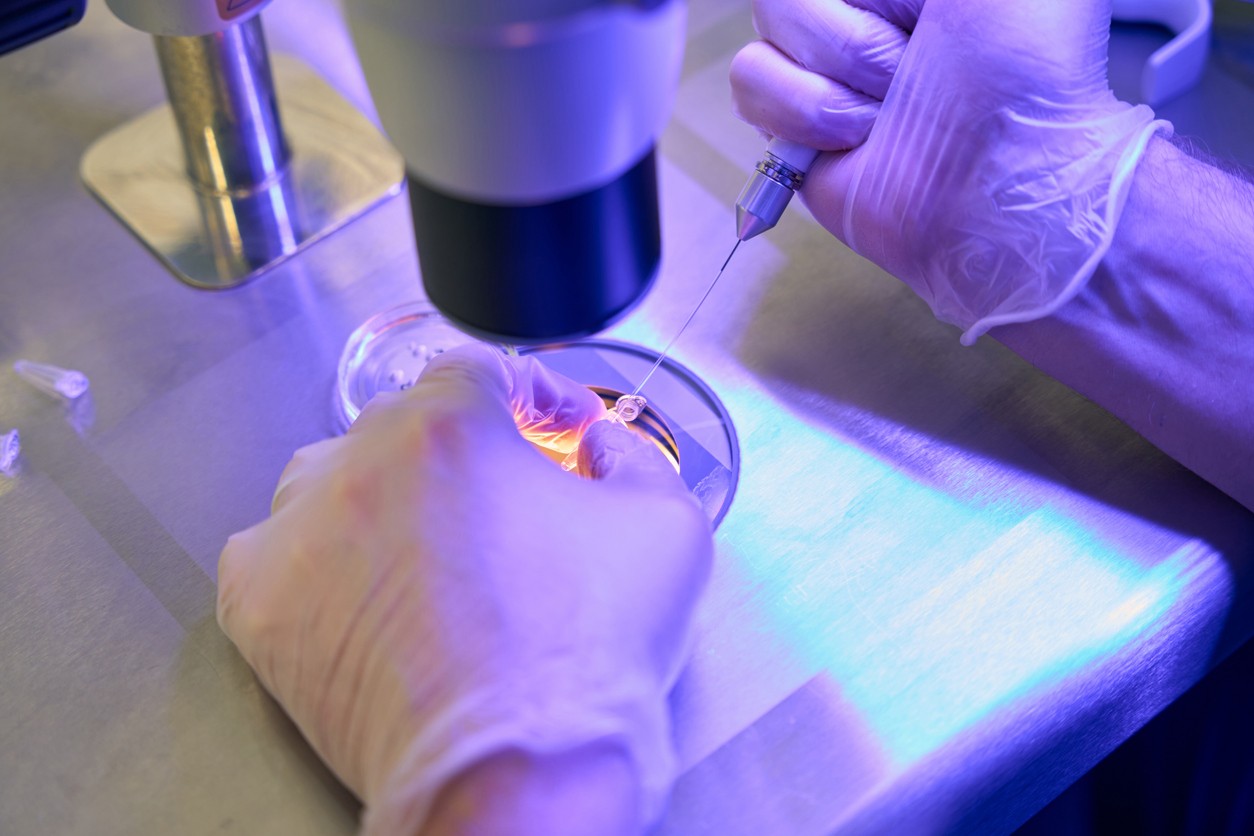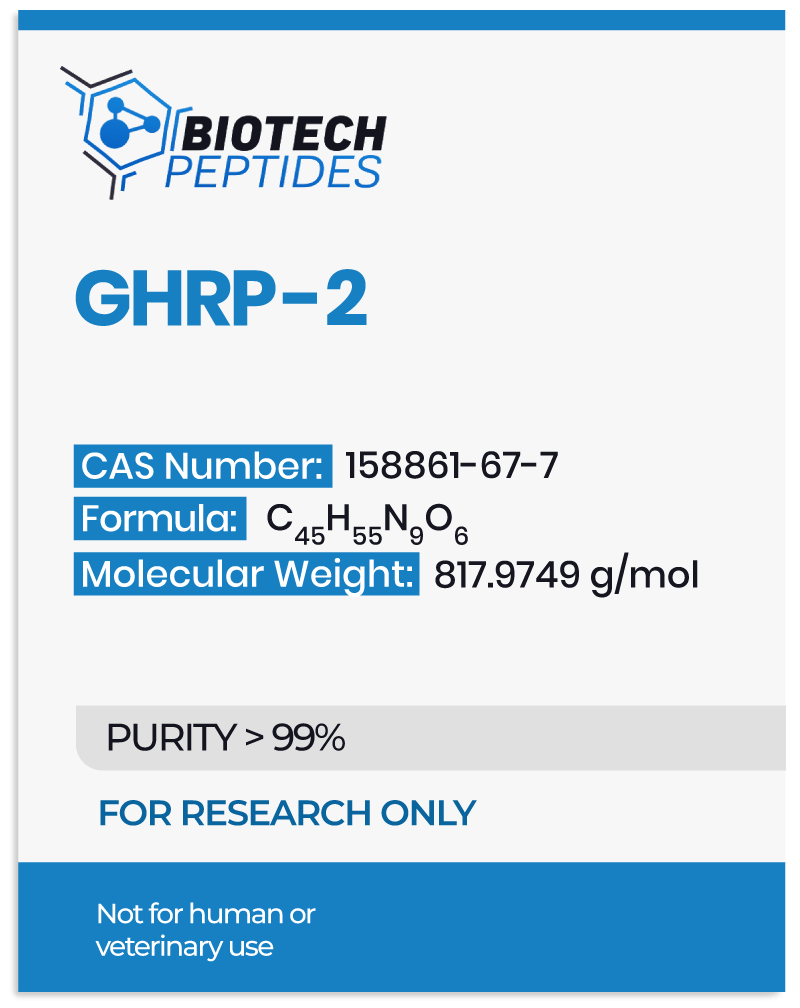Growth Hormone Releasing Peptide-2 (GHRP-2), also known as pralmorelin, stands as a synthetic peptide reportedly designed to mimic the actions of ghrelin,[1] an endogenous peptide considered to be crucial in various physiological processes. Ghrelin, initially discovered in stomach tissues and comprised of 28 amino acids, is considered by scientists to play pivotal roles in regulating food intake, growth hormone release, and wound healing.[2]
GHRP-2, the pioneer among growth hormone secretagogues, has been suggested by researchers to operate by binding to the ghrelin/growth hormone secretagogues receptor, thereby triggering the secretion of growth hormone.
Additionally, studies conducted in bovine models have indicated potential multifaceted impacts of GHRP-2, suggesting its involvement in stimulating growth hormone secretion via interactions with growth hormone release factor receptors, calcium channels, and signaling pathways like the cAMP pathway and protein kinase C activation.[3]
These mechanisms are speculated to collectively contribute to the elevation of growth hormone levels, implicating GHRP-2 as a promising agent in various physiological contexts.
GHRP-2 Peptide and Growth Hormone (GH) Deficiency
Existing conventional procedures to identify growth hormone (GH) deficiency may involve testing insulin tolerance; however, they may potentiate adverse effects and contradictions. To address these limitations, one investigation[4] sought to evaluate the utility of Growth Hormone Releasing Peptide-2 (GHRP-2) as an alternative diagnostic for GH deficiency in laboratory settings.
The researchers conducted initial testing of the research model via ITT. Blood samples were collected and analyzed after a 2-hour interval. Results indicated a consistent peak in GH levels one hour post-GHRP-2 exposure. However, a marginal decrease in efficacy was observed in certain models of obesity or advanced age. The study results suggest the diagnostic potential of GHRP-2 in severe GH deficiency research, acknowledging minor influences from age and adiposity levels.
In a separate study[3], the diagnostic efficacy of GHRP-2 compared to conventional compounds often studied in conjunction with growth hormone deficiency (GHD) was explored. Research models of GHD, having undergone exposure with at least one conventional medication, were subjects of this study. The researchers suggested that additional exposure to GHRP-2 may have acted as a reliable predictor of the pituitary gland’s capacity to release GH, a feature not reported with the conventional compounds in isolation.
GHRP-2 Peptide and Caloric Intake
In a controlled experimental setting,[6] researchers attempted to investigate the impact of Growth Hormone Releasing Peptide-2 (GHRP-2) on food consumption. An experimental research model group was exposed to GHRP-2, compared to a separate control group exposed to saline over a 4.5-hour period. Subsequently, researchers monitored food intake. Results indicated a notable increase in food consumption among the GHRP-2 group, exhibiting a mean increase of approximately 36% compared to the saline group.
These findings suggest the possible action of GHRP-2 in stimulating appetite, as indicated by the substantial increase in food consumption observed in the experimental group. Moreover, the concurrent rise in GH levels further underlies the hypothetical physiological action of GHRP-2 in regulating appetite and metabolism.
General Action
Numerous investigations[5] conducted on animals elucidate the potential impacts of GHRP-2 peptide. In both rabbits and guinea pigs, the exposure of GHRP-2 appears to exhibit no discernible effects on the central nervous system. Notably, apart from a modest increase in the motility of the isolated rabbit ileum and enhanced contraction of the isolated guinea pig ileum at higher GHRP-2 concentrations, no other significant effects were observed. Moreover, GHRP-2 exposure reportedly may not elicit alterations in the respiratory, digestive, renal, and circulatory systems. As per the researchers, the peptide “has no serious general [effects] at [concentration] levels showing GH-releasing activity in the experimental animals,” and the peptide is speculated to support the diagnosis of “serious GH deficiency and short stature.”[5]
Combination Studies with TRH and GnRH
A research study[7] aimed to assess the effects of GHRP-2, Thyrotropin Releasing Hormone (TRH), and Gonadotropin Releasing Hormone (GnRH) alone and in various combinations on research models of prolonged hyposomatotropism, hypogonadism, or hypothyroid complications.
Over the course of five days, the researchers evaluated the action of three compounds: placebo, GHRP-2 alone every hour, GHRP-2 and TRH every hour, and GHRP-2, TRH, and GnRH every 90 minutes. Serum samples were collected on the first and last nights of the study period for analysis.
Analysis of the results suggests that the combination of GHRP-2, GnRH, and TRH elicited the most pronounced activation of growth hormone, thyroid stimulating hormone, and luteinizing hormone axes, accompanied by potential metabolic effects. Conversely, the effects observed with GHRP-2 alone were reported to be minimal, and even the combination of GHRP-2 and TRH appeared to only partially induce similar effects compared to the triple combination regimen.
These findings underscore the potential synergistic action of GHRP-2 with GnRH and TRH in eliciting robust hormonal responses in experimental settings.
Disclaimer: The products mentioned are not intended for human or animal consumption. Research chemicals are intended solely for laboratory experimentation and/or in-vitro testing. Bodily introduction of any sort is strictly prohibited by law. All purchases are limited to licensed researchers and/or qualified professionals. All information shared in this article is for educational purposes only.
References:
- Garcia JM, Merriam GR, Kargi AY. Growth Hormone in Aging. In: Feingold KR, Anawalt B, Blackman MR, et al., editors. Endotext. South Dartmouth (MA): MDText.com. https://www.ncbi.nlm.nih.gov/books/NBK279163/
- GHRP 2, GPA 748, Growth Hormone-Releasing Peptide 2, KP-102 D, KP-102 LN, KP-102D, KP-102 LN. https://link.springer.com/article/10.2165/00126839-200405040-00011#
- Asad Rahim, Stephen M. Shalet, in Growth Hormone Secretagogues, 1999. Does desensitization to growth hormone secretagogues occur? https://www.sciencedirect.com/topics/medicine-and-dentistry/pralmorelin
- Roh SG, He ML, Matsunaga N, Hidaka S, Hidari H. Mechanisms of action of growth hormone-releasing peptide-2 in bovine pituitary cells. J Anim Sci. 1997 Oct;75(10):2744-8. doi: 10.2527/1997.75102744x. PMID: 9331879. https://pubmed.ncbi.nlm.nih.gov/9331879/
- Furuta S, Shimada O, Doi N, Ukai K, Nakagawa T, Watanabe J, Imaizumi M. General pharmacology of KP-102 (GHRP-2), a potent growth hormone-releasing peptide. Arzneimittelforschung. 2004;54(12):868-80. doi: 10.1055/s-0031-1297042. PMID: 15646371. https://pubmed.ncbi.nlm.nih.gov/15646371/
- Laferrère, Blandine et al. Growth hormone releasing peptide-2 (GHRP-2), like ghrelin, increases food intake in healthy men. The Journal of clinical endocrinology and metabolism vol. 90,2 (2005): 611-4. https://www.ncbi.nlm.nih.gov/pmc/articles/PMC2824650/
- Van den Berghe G, Baxter RC, Weekers F, Wouters P, Bowers CY, Iranmanesh A, Veldhuis JD, Bouillon R. The combined administration of GH-releasing peptide-2 (GHRP-2), TRH and GnRH to men with prolonged critical illness evokes superior endocrine and metabolic effects compared to treatment with GHRP-2 alone. Clin Endocrinol (Oxf). 2002 May;56(5):655-69. doi: 10.1046/j.1365-2265.2002.01255.x. PMID: 12030918. https://pubmed.ncbi.nlm.nih.gov/12030918/
- Image source: National Center for Biotechnology Information (2024). PubChem Compound Summary for CID 6918245, Pralmorelin. https://pubchem.ncbi.nlm.nih.gov/compound/Pralmorelin.







